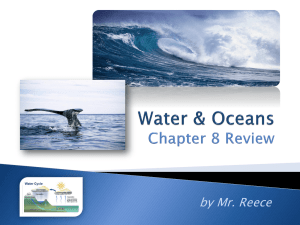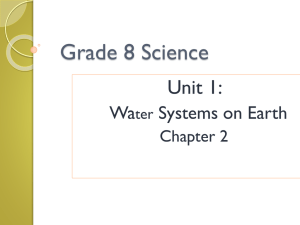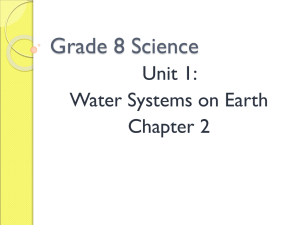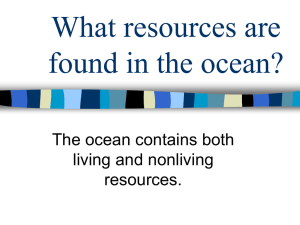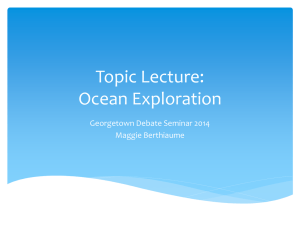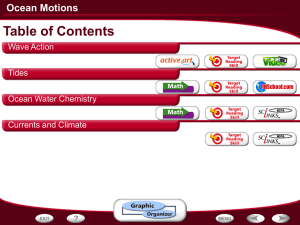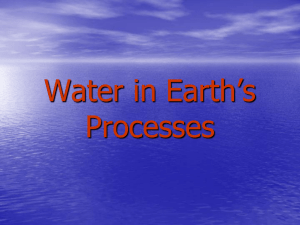Characteristics of Ocean Water
advertisement
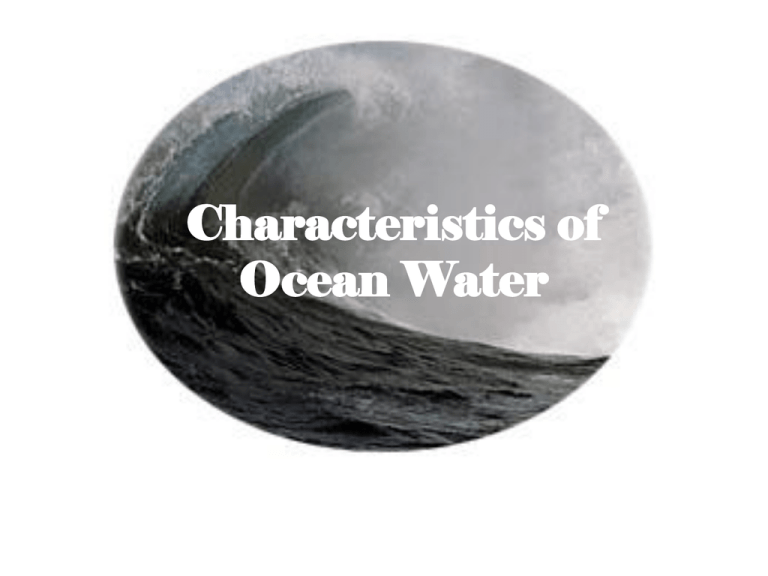
Characteristics of Ocean Water • Oceanography covers physical properties of the ocean: –Dissolved materials: minerals and salts (salinity) and gases –Properties that change with depth: light, temperature and pressure –Motion: Waves, tides, currents Waters Unique Properties… -Found in 3 states of matter on our planet -High heat capacity: ability of water to hold heat energy and regulate our climate -Universal solvent: can dissolve more things than any other solvent Unique Properties of water are due to Hydrogen Bondingattraction between water molecules because of the unequal charges of O & H • Charges on O and H help it dissolve things like salts • Attraction between water molecules- a lot of heat is needed to increase water temp and when water cools it release a lot of heat Salinity • Result of weathering of rocks on land carried by rivers to the ocean • Materials from the earth’s interior – Hydrothermal vents – Volcanic eruptions Materials in Seawater –Oceans have an average salinity of 3.5% or 35 ppt (35 ‰) – ppt= parts per thousand –More than 70 elements in seawater but the main ones are.. Chloride Sodium Sulphate Magnesium Calcium Potassium Dissolved Gases • Oxygen, carbon dioxide and nitrogen • Dissolve into the ocean from the atmosphere through wave action • Dissolve better in cold water • Animal life can change the chemistry of ocean gases • Around 500 m water runs out of oxygen –Bacteria and other animals are using it during decomposition and respiration • Animals in this region and lower have large gills, modified hemoglobin or are inactive Pressure • We are under 1 atmosphere (atm) of pressure on land • Water is heavier than air so every 10 m deep = 1 more atm of pressure Animal Adaptations and Pressure • Ocean life has adapted to deep ocean and 1000x our pressure with lightweight skeletons, little musculature, and reduced metabolic, growth and reproductive rates. • Diving mammals have rib cages that collapse and expand in result to changing pressure Water Depth vs Light • Photosynthetic organisms use light to make sugars. • Sunlit area (top 100 meters) contains 90% of marine life • Colors of penetrate thru water differently – Red light filters out first and blue light goes the furthest – Red animals are essentially invisible in deep waters Energy in the Ocean • Ocean takes longer to heat and cool than land due to its specific heat • Water temp decreases with depth Animal Adaptations and Temperature • Colder temps reduce the metabolic rate • In very cold waters fish have a special protein like antifreeze to keep tissues from freezing • Lighter colored animals stay cooler than darker colored animals and are found in warmer waters • Some marine life have thick layers of fat to insulate their bodies Motion in the Ocean…Tides • Daily rise and fall of the ocean (high and low tide) • Range as small as 1 m & as high as 20m • Some areas have 1 or 2 high & low tides • Caused by gravitational pull of moon on our ocean basin Moon/ Sun TIDES •Tides rise (FLOOD) to produce a HIGH TIDE • And fall (EBB) (LOW TIDE) This side is pulled towards the Sun and/or Moon by gravitational attraction This side bulges out because of inertia Therefore, there are two high tides on Earth at any one time Marine Life and Tides • Some marine life time their reproduction to the high or low tide cycle • Horseshoe crabs come ashore to mate on the night of a high tide in May • Eggs hatch 2 wks later on a high tide and are washed into the ocean Motion in the Ocean…Waves • Winds produce waves as it blows across the ocean’s surface • When waves enter shallow water they drag along the ocean floor • The wave top is moving faster than the wave bottom so it topples forward • Specialty waves: rogue waves, tidal waves and tsunamis At the shoreline • Surf sequence of breaking waves • Swash - water sliding up beach • Backwash water flowing back down beach to sea Longshore drift • Waves arrive at a coast at an angle (swash) • Backwash returns at 90 degrees Sand is moved along the beach = longshore drift or longshore current Coastal deposition • Result of longshore drift and a lot of sediment • produces extensions of deposit from the shoreline spit = curved extension • May grow across a bay (baymouth bar) • May link an island to the main land (tombolo) Motion in the Ocean-Currents • Rivers of water moving through the ocean • Surface currents caused by major wind belts • Deflected by the Coriolis Effect • Important in moving marine life and nutrients around the oceans Vertical Ocean Currents • Differences in temperature and salinity change the density of water. • This causes sinking and rising of water in the ocean • Ocean conveyor belt- convection current of water moving between the equator and poles in the oceans • Takes 1600 years to cycle



